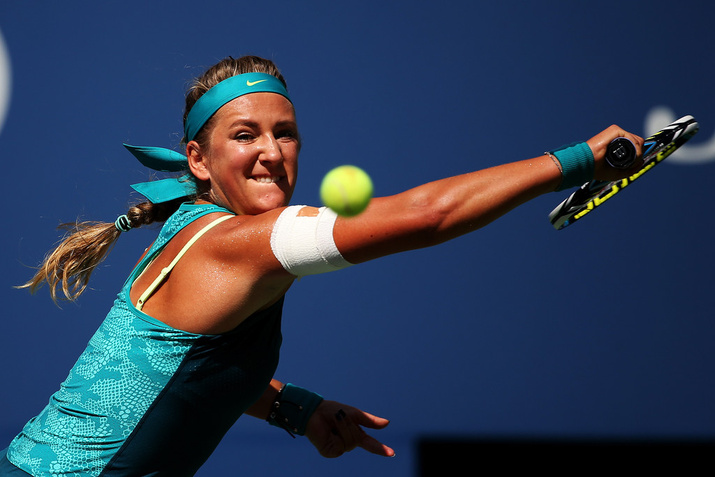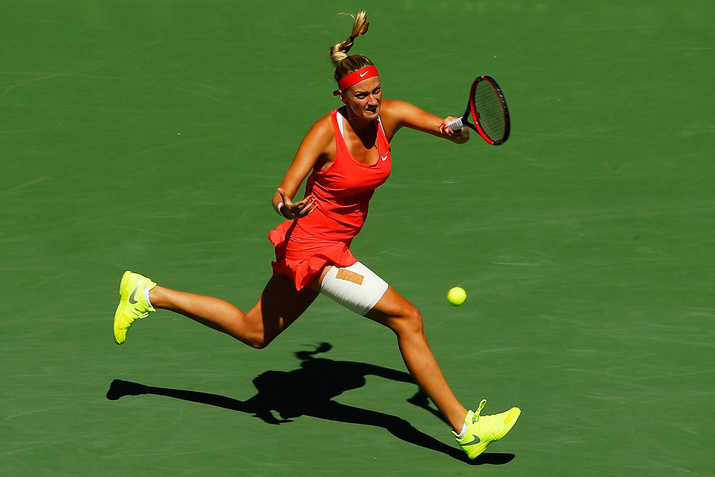Don't miss any stories → Follow Tennis View
FollowAzarenka, Kvitova Seek to Set Semifinal Clash
When the draw came out for the 2015 US Open, the prospect of a quarterfinal clash between Simona Halep and Victoria Azarenka seemed intriguing to many seasoned tennis viewers. The match is an appealing clash of styles between two of the most talented players in the women’s game, but the Romanian and the Belarusian do share one key quality, fighting spirit, and it has been instrumental in their runs to the quarterfinals.
For a long time during her fourth-round match with Sabine Lisicki, it looked like Halep’s stay at Flushing Meadows would come to an end. After winning an error-strewn first set 7-6, the big-hitting German failed to capitalize when the Romanian was fighting leg pain and playing poorly during the second set, somehow losing it 7-5. Halep drew on all her reserves of determination to raise her game in the third set and win it 6-2. Before the match, Halep had breezed through rounds one to three with straight-sets victories over Marina Erakovic (who retired in the second set), Kateryna Bondarenko, and Shelby Rogers.

Like Halep, Azarenka has won three of her matches (against Lucie Hradecka, Yanina Wickmayer, and Varvara Lepchenko) with a minimum of fuss and been severely tested in her other clash. Unlike Halep- Lisicki, however, Azarenka’s match with Angelique Kerber in the third round was a high-quality encounter that brought the best out of both players. There were seven breaks of serve in the opening set as neither player seemed keen to let the other settle, and it was Azarenka who held her nerve in the crucial moments at the end of the set to take it 7-5. The world No. 20’s level dropped significantly during the second set, which she lost 6-2, but she superbly combined aggression with precision in the third to win it 6-4.
Azarenka has only lost six games in her two previous matches against Halep, but they were both in 2012, and the Romanian has improved significantly since then, so that head-to-head record tells us very little. Azarenka will look to dominate the play and keep Halep constantly on the back foot, but the world No. 2 is arguably the best in the women’s game at chasing down seemingly lost causes and turning them to her advantage.
If such a pattern emerges during the match, and long rallies develop as a result, the player who wins those points will probably win the match. Lengthening the points definitely seems like a sensible ploy for Halep, since if Azarenka is allowed to win a succession of quick points, she is capable of finding a near-irresistible rhythm and reeling off several games in a row – something she even managed to do at the beginning of her Wimbledon quarterfinal against Serena Williams. All told, Halep-Azarenka is a very tough match to call, particularly since both players will fight until the last point, and it has the potential to be genuinely epic.

If Petra Kvitova is at her best, she can beat anyone in the women’s game, including Serena Williams. But she has not been playing as well as she can during the 2015 US Open, so facing veteran Flavia Pennetta in the quarterfinal could prove to be a much tougher proposition than expected.
The Italian, at age 33, has grown in confidence throughout this year’s last Grand Slam, following up an unconvincing first-round win over Jarmila Gajdosova with an impressive dismantling of Monica Niculescu and a gutsy win over Caroline Wozniacki’s talented conqueror, Petra Cetkovska.
These victories led her to a fourth-round clash with an opponent whom she had beaten in all of their six previous meetings – Samantha Stosur. And Pennetta triumphed again, putting her extensive knowledge of the Australian’s game to good use as she won both sets 6-4.
Kvitova’s run to the quarterfinals looks straightforward on paper, since she has beaten four opponents – Laura Siegemund, Nicole Gibbs, Anna Schmiedlova, and Johanna Konta – in straight sets. However, she made her second-round win over Gibbs more difficult than it should have been by making 27 unforced errors, and she could easily have lost to Konta if the British player had taken one or more of her break point opportunities.
Their head-to-head record stands at 3-3, and they have not played each other since 2012, so it does not give us many clues as to which way the match is going to go. The key challenge for Pennetta will be coping with Kvitova’s power hitting. If she can draw the Czech into long rallies and perhaps even tire her out, her chances of winning will increase. Like her previous opponent, Stosur, Kvitova is strongest on her forehand side, so Pennetta should look to target her backhand.
The 25-year-old Czech lefty is at her most dominant when she keeps the points short, dragging her opponents into one area of the court before hammering the ball into another. Frequently carving out this type of point also carries the advantage of never letting opponents settle into a rhythm, and if Kvitova can do this against Pennetta, she will surely win. If the match becomes a drawn-out battle, however, it is anybody’s game.










